|
|
|
Sort Order |
|
|
|
Items / Page
|
|
|
|
|
|
|
| Srl | Item |
| 1 |
ID:
099230
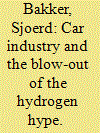

|
|
|
|
|
| Publication |
2010.
|
| Summary/Abstract |
The hydrogen hype of the last decade has passed and it is now seemingly substituted by the electric vehicle hype. A technological hype can have both positive as well as negative consequences. On the one hand it attracts sponsors for technology development but on the other hand the high expectations might result in disappointment and subsequent withdrawal of the sponsors. In this paper I ask the question to what extent the car industry has created the hype and how it has done so. The industry's role is studied through their prototyping activities and accompanying statements on market entry. I conclude that the car industry has indeed inflated the hype, especially through its public statements on market release after the turn of the millennium. Furthermore, it can be concluded that the industry has shown a double repertoire of both highly optimistic and more modest statements. It is possible that statements are used deliberately to serve the industry's interests whenever needed. Without neglecting the positive influence of technological hype on public policy and private funding for R&D efforts, more modest promises could serve the development of sustainable mobility better. For policy makers the challenge is to remain open to different options instead of following hypes and disappointments as they come and go.
|
|
|
|
|
|
|
|
|
|
|
|
|
|
|
|
| 2 |
ID:
088976


|
|
|
|
|
| Publication |
2009.
|
| Summary/Abstract |
In this paper, several designs of hybrid PV-wind (photovoltaic-wind) systems connected to the electrical grid, including the intermittent production of hydrogen, are shown. The objective considered in the design is economical to maximise the net present value (NPV) of the system.
A control strategy has been applied so that hydrogen is only produced by the electrolyser when there is an excess of electrical energy that cannot be exported to the grid (intermittent production of hydrogen).
Several optimisation studies based on different scenarios have been carried out. After studying the results - for systems with which the produced hydrogen would be sold for external consumption - it can be stated that the selling price of hydrogen should be about 10 €/kg in areas with strong wind, in order to get economically viable systems.
For the hydrogen-producing systems in which hydrogen is produced when there is an excess of electricity and then stored and later used in a fuel cell to produce electricity to be sold to the grid, even in areas with high wind speed rate, the price of electrical energy produced by the fuel cell should be very high for the system to be profitable.
|
|
|
|
|
|
|
|
|
|
|
|
|
|
|
|
| 3 |
ID:
186421


|
|
|
|
|
| Summary/Abstract |
Recently, the concept of sustainable cities has become increasingly important because of serious technical and environmental challenges stemming from global warming. These challenges are related to an increase in the energy demand of cities, which is still met by non-renewable energy sources that release CO2 into the atmosphere. A carbon-free economy should be planned in a sustainable way by utilizing renewable energy sources and sustainable technologies. In this context, planning and implementing a hydrogen economy can be one solution to prevent these problems; sustainable urban planning has become a more complex issue, considering all these problems together. The main objectives in doing the present study are twofold, namely: (i) to provide an overview of the current status of hydrogen city projects and (ii) a conceptual hydrogen city planning model is presented for policy and decision makers. In this study, the initial hydrogen city projects are reviewed and summarized. And a conceptual hydrogen city planning model is presented for minimizing the carbon footprint of the cities. As can be concluded based on the status of the initial hydrogen city projects, which have been investigated and presented, these projects need more time to complete by considering the energy efficient technology.
|
|
|
|
|
|
|
|
|
|
|
|
|
|
|
|
| 4 |
ID:
153753


|
|
|
|
|
| Summary/Abstract |
This paper examines the features of the dirigible airship as a flying vehicle, its strengths and weaknesses, possibilities of employment in peacetime and use for military purposes.
|
|
|
|
|
|
|
|
|
|
|
|
|
|
|
|
| 5 |
ID:
176125
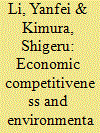

|
|
|
|
|
| Summary/Abstract |
Hydrogen as an energy carrier faces challenges such as high costs of hydrogen supply, high cost of fuel cell electric vehicles (FCEVs), and substantial infrastructure requirements. However, leading countries have announced long-term plan and targets in developing hydrogen energy. Should the Association of Southeast Asian Nations (ASEAN) follow up such developments? This study asks if hydrogen-based road transport, especially FCEVs in the fleets of passenger cars, buses, and trucks, could be economically justified in the ASEAN member states. If not, what strategies to take for ASEAN member states? The study applies a well-to-wheel model and a total cost of ownership model to compare the energy consumption, carbon emissions, as well as the costs of FCEVs with those of alternative powertrains. This practice shows the scale of the cost gaps. Subsequently, it estimates the implications of predicted future developments of both hydrogen and FCEVs, in terms of costs and carbon emissions reduced. The results indicate the areas in which FCEVs are most likely to become competitive in the near future, and thus could be targeted and prioritised. By comparing the country-specific results, implications are extended to what policies are most relevant in facilitating the development of hydrogen and fuel cell.
|
|
|
|
|
|
|
|
|
|
|
|
|
|
|
|
| 6 |
ID:
128724
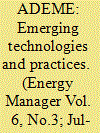

|
|
|
| 7 |
ID:
098539


|
|
|
|
|
| Publication |
2010.
|
| Summary/Abstract |
In recent years, a number of initiatives have been supported in Europe in the hydrogen energy sector. Communities can play an important role in the adoption process of these emerging technologies: supporting pre-commercial deployment, building public acceptance, and promoting innovation clusters, all of which lay the foundations for more widespread and sustained technology deployment. Participation by communities is hinged on the perceived contribution of technology adoption to community socio-economic and energy related goals, such as, climate change mitigation, air quality improvement, creation of new industries and businesses, exploitation of abundant renewable resources, and meeting growing energy needs. Hydrogen uptake in communities therefore stands to benefit development of the hydrogen energy sector and the communities themselves. This paper presents a methodology for evaluating the potential for successful large-scale hydrogen and fuel cell technology adoption-beyond demonstration projects-within defined community frameworks. This methodology can be a valuable tool, for community decision-makers and industry stakeholders alike, to evaluate and identify opportunities for large-scale hydrogen technology adoption. Results of applying the methodology are presented for three community types: islands, cities and regions. The work in this paper reflects work done within the frame of the European Commission-funded 'Roads2HyCom' project, Work Package 3.1
|
|
|
|
|
|
|
|
|
|
|
|
|
|
|
|
| 8 |
ID:
111431


|
|
|
|
|
| Publication |
2012.
|
| Summary/Abstract |
Exergy analysis has been shown to be an efficient tool for understanding and improvement of industrial processes. In the present study, exergy analysis has been used to examine the energy consumption of an existing Steam Methane Reforming (SMR) process and then to test for possible savings in primary energy consumption and environmental protection.
In the first step, energy and exergy balances of a steam methane reforming process were established to identify the thermodynamic imperfections of the process. Recommendations from this study have contributed to the building of a new and more efficient process. Consequently, a heat exchanger, corresponding to 44.9% of the total required area for the SMR heat exchange, has been incorporated in the SMR for waste heat recovery.
The thermal and exergetic efficiencies of the original process are 70% and 65.5%, respectively. For the new process, the thermal and exergetic efficiencies are 74% and 69.1%, respectively. The unused exergy is reduced by 9.3% from 125.9 to 114.2 kJ per mole of H2 produced. One mole of methane produces 2.48 mol of H2 compared to 2.35 mol of H2 produced in the original process. Furthermore, the new SMR process produces the lower greenhouse gas emissions.
|
|
|
|
|
|
|
|
|
|
|
|
|
|
|
|
| 9 |
ID:
183038
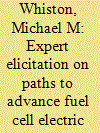

|
|
|
|
|
| Summary/Abstract |
While fuel cell electric vehicles (FCEVs) fueled by hydrogen produced using low-carbon processes could considerably reduce carbon emissions from transportation, FCEVs are produced at low volume, are expensive to manufacture, and lack widespread refueling infrastructure. To inform advancement pathways for FCEVs, we conducted an expert elicitation on vehicle costs and performance at anticipated production volumes, governmental actions to advance FCEVs, anticipated sales of FCEVs equipped with an automated driving system (ADS), and anticipated infrastructure deployments. Between 2020 and 2035, experts assessed a three-fold decline in fuel cell system costs to $60/kW and over an order of magnitude increase in production volume to 225,000 systems/year. Levelized costs of driving were assesed at $0.25–$0.90/mile and $0.17–$0.65/mile in 2035 and 2050, respectively. FCEVs could constitute a considerable share of ADS-equipped vehicle sales depending on cost and performance trajectories of automated driving technology and electric vehicles. Experts identified regulatory and incentive-based policies as important governmental actions to advance FCEVs and recommended hydrogen, fuel cells, and technology deployment activities each receive at least 20% of government research and development funding. Medians of experts' U.S. refueling station deployment assessments were 500 and 2,000 stations cumulative in 2030 and 2040, respectively. The middle 50% of respondents anticipated 2030 cumulative FCEV deployments in China of 100,000–1 million.
|
|
|
|
|
|
|
|
|
|
|
|
|
|
|
|
| 10 |
ID:
103397
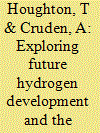

|
|
|
|
|
| Publication |
2011.
|
| Summary/Abstract |
It is generally recognised that the primary tools being utilised today for hydrogen energy forecasting and policy development take a least-cost approach. While useful for comparing the viability of different technologies from a cost perspective, it is argued that these models fail to capture the potential value contribution such technologies could offer companies and, in consequence, the likelihood of their receiving investment. The authors propose a novel model for forecasting the deployment of hydrogen energy systems based on a company value maximisation approach designed to assist governments in the development of appropriate policy instruments. In this paper a theoretical relationship between market sector valuations and investment activity is presented using 3 value metrics, namely net present value (NPV), earnings per share (EPS) and sum of the parts (SOP). It is shown that, as the electricity and transport fuel markets begin to converge, examination of the effects of different policy measures through the value-led model can highlight otherwise hidden counter incentives. The model further recognises that the propensity to invest in hydrogen differs according to the characteristics of the company looking to make the investment and the implications for policy-makers regarding levels of support are also discussed in the paper.
|
|
|
|
|
|
|
|
|
|
|
|
|
|
|
|
| 11 |
ID:
125690


|
|
|
|
|
| Publication |
2013.
|
| Summary/Abstract |
Fossil fuels use has caused serious environmental impacts worldwide, mainly related with the greenhouse effect intensification. One strategy to mitigate such impacts is the use of hydrogen in combustion processes. Additionally, hydrogen can be utilized as an energy vector for storage purposes and is also classified as a fuel of the future, due to the low emission of pollutants into the atmosphere. The present paper shows results of a computational simulation carried out for the state of Ceará, Brazil, considering scenarios for the use of electrolytic hydrogen obtained with the use of photovoltaic (PV) modules and wind energy converters, as a substitute of fluid fossil fuels.
|
|
|
|
|
|
|
|
|
|
|
|
|
|
|
|
| 12 |
ID:
124256
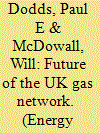

|
|
|
|
|
| Publication |
2013.
|
| Summary/Abstract |
The UK has an extensive natural gas pipeline network supplying 84% of homes. Previous studies of decarbonisation pathways using the UK MARKAL energy system model have concluded that the low-pressure gas networks should be mostly abandoned by 2050, yet most of the iron pipes near buildings are currently being replaced early for safety reasons. Our study suggests that this programme will not lock-in the use of gas in the long-term. We examine potential future uses of the gas network in the UK energy system using an improved version of UK MARKAL that introduces a number of decarbonisation options for the gas network including bio-methane, hydrogen injection to the natural gas and conversion of the network to deliver hydrogen. We conclude that hydrogen conversion is the only gas decarbonisation option that might enable the gas networks to continue supplying energy to most buildings in the long-term, from a cost-optimal perspective. There is an opportunity for the government to adopt a long-term strategy for the gas distribution networks that either curtails the iron mains replacement programme or alters it to prepare the network for hydrogen conversion; both options could substantially reduce the long-term cost of supplying heat to UK buildings.
|
|
|
|
|
|
|
|
|
|
|
|
|
|
|
|
| 13 |
ID:
088034


|
|
|
|
|
| Publication |
2009.
|
| Summary/Abstract |
This paper presents an hourly management method for energy generated in grid-connected wind farms using battery storage (Wind-Batteries systems). The method proposed is analysed technically and economically.
Electricity generation in wind farms does not usually coincide with the electrical demand curve. If the wind-power penetration becomes high in the Spanish electrical grid, energy management will become necessary for some wind farms. A method is proposed in this paper to adjust the generation curve to the demand curve by storing electrical energy in batteries during off-peak hours (low demand) and selling stored energy to the grid during peak hours (high demand).
With the results obtained and reported in this paper, for a Wind-Batteries system to be economically as profitable as a Wind-Only system, the selling price of the energy provided by the batteries during peak hours should be between 22 and 66 c€/kWh, depending on the technology and cost of the batteries. Comparison with flexible thermal generation has been performed.
Additionally, the results are compared with those obtained if using hydrogen (Wind-Hydrogen system, which uses an electrolyser, hydrogen tank, and fuel cell instead of batteries), concluding that the Wind-Batteries system is both economically and energetically far more suitable.
|
|
|
|
|
|
|
|
|
|
|
|
|
|
|
|
| 14 |
ID:
088035


|
|
|
|
|
| Publication |
2009.
|
| Summary/Abstract |
This paper presents an hourly management method for energy generated in grid-connected wind farms using battery storage (Wind-Batteries systems). The method proposed is analysed technically and economically.
Electricity generation in wind farms does not usually coincide with the electrical demand curve. If the wind-power penetration becomes high in the Spanish electrical grid, energy management will become necessary for some wind farms. A method is proposed in this paper to adjust the generation curve to the demand curve by storing electrical energy in batteries during off-peak hours (low demand) and selling stored energy to the grid during peak hours (high demand).
With the results obtained and reported in this paper, for a Wind-Batteries system to be economically as profitable as a Wind-Only system, the selling price of the energy provided by the batteries during peak hours should be between 22 and 66 c€/kWh, depending on the technology and cost of the batteries. Comparison with flexible thermal generation has been performed.
Additionally, the results are compared with those obtained if using hydrogen (Wind-Hydrogen system, which uses an electrolyser, hydrogen tank, and fuel cell instead of batteries), concluding that the Wind-Batteries system is both economically and energetically far more suitable.
|
|
|
|
|
|
|
|
|
|
|
|
|
|
|
|
| 15 |
ID:
191219


|
|
|
|
|
| Summary/Abstract |
Hydrogen can be key in the energy system transition. We investigate the role of offshore hydrogen generation in a future integrated energy system. By performing energy system optimisation in a model application of the Northern-central European energy system and the North Sea offshore grid towards 2050, we find that offshore hydrogen generation may likely only play a limited role, and that offshore wind energy has higher value when sent to shore in the form of electricity. Forcing all hydrogen generation offshore would lead to increased energy system costs. Under the assumed scenario conditions, which result in deep decarbonisatiton of the energy system towards 2050, hydrogen generation – both onshore and offshore – follows solar PV generation patterns. Combined with hydrogen storage, this is the most cost-effective solution to satisfy future hydrogen demand. Overall, we find that the role of future offshore hydrogen generation should not simply be derived from minimising costs for the offshore sub-system, but by also considering the economic value that such generation would create for the whole integrated energy system. We find as a no-regret option to enable and promote the integration of offshore wind in onshore energy markets via electrical connections.
|
|
|
|
|
|
|
|
|
|
|
|
|
|
|
|
| 16 |
ID:
171515


|
|
|
|
|
| Summary/Abstract |
Hydrogen can be produced from many different renewable and non-renewable feedstocks and technological pathways, with widely varying greenhouse gas emissions. For hydrogen to have a role in future low-carbon energy systems, it is necessary to demonstrate that it has sufficiently low carbon emissions. This paper explores how green hydrogen has been defined, reviews nascent green hydrogen characterisation initiatives, and highlights the main challenges that standards and guarantee of origin schemes must overcome to develop a market for green hydrogen.
Most existing green hydrogen initiatives are in Europe. In anticipation of a future market for green hydrogen, international standards are starting to be discussed by national and international standardisation organisations and policy makers. A range of approaches have been taken to defining green hydrogen and guarantees of origin. These vary on whether green hydrogen must be produced from renewable energy, on the boundaries of the carbon accounting system, the emission thresholds at which hydrogen is considered green, and on which feedstocks and production technologies are included in the scheme. Decisions on these factors are often influenced by other national and international standards, and the legal framework in which the green hydrogen supply chain operates.
|
|
|
|
|
|
|
|
|
|
|
|
|
|
|
|
| 17 |
ID:
088025


|
|
|
|
|
| Publication |
2009.
|
| Summary/Abstract |
Hydrogen is an energy carrier able to be produced from domestic, zero-carbon sources and consumed by zero-pollution devices. A transition to a hydrogen-based economy could therefore potentially respond to climate, air quality, and energy security concerns. In a hydrogen economy, both mobile and stationary energy needs could be met through the reaction of hydrogen (H2) with oxygen (O2). This study applies a full fuel cycle approach to quantify the energy, greenhouse gas emissions (GHGs), and cost implications associated with a large transition to hydrogen in the United States. It explores a national and four metropolitan area transitions in two contrasting policy contexts: a "business-as-usual" (BAU) context with continued reliance on fossil fuels, and a "GHG-constrained" context with policies aimed at reducing greenhouse gas emissions. A transition in either policy context faces serious challenges, foremost among them from the highly inertial investments over the past century or so in technology and infrastructure based on petroleum, natural gas, and coal. A hydrogen transition in the USA could contribute to an effective response to climate change by helping to achieve deep reductions in GHG emissions by mid-century across all sectors of the economy; however, these reductions depend on the use of hydrogen to exploit clean, zero-carbon energy supply options.
|
|
|
|
|
|
|
|
|
|
|
|
|
|
|
|
| 18 |
ID:
125871


|
|
|
|
|
| Publication |
2013.
|
| Summary/Abstract |
The HyFrance Group was originally formed in France to support the European project HyWays, by providing (former projects HyFrance1 and HyFrance2) the French data and possible hydrogen pathways according to the national specificities. HyFrance3 is a new project that focuses on the economic competitiveness of different steps of the hydrogen chain, from the production to the end use, at the time horizon of 2030 in France. HyFrance3 is a 10 partners' project coordinated by the CEA. The project addresses the present and future French hydrogen industrial markets for chemical and refinery uses, the analysis of the interplay between wind energy production and storage of hydrogen for different automotive requirements (refuelling stations, biofuel plants, Hydrogen/Natural Gas mix), the massive hydrogen storage to balance various supply and demand characteristics, and the supply network (pipeline option competitiveness vs. trucked in supply) to distribute hydrogen in a French region for automotive applications. Technical and economical issues are addressed.
The future industrial hydrogen demand in France will be over 106 t/year ca. 2030, and could be doubled if there is a use for reduction in the steel industry. If hydrogen is produced by electrolysis from wind energy systems, the costs vary from ca. 4 to 20 €/kg, depending strongly on the type of demand and the connexion rate to the grid. At a French regional scale, hydrogen use for transports needs mass storage (at least 103 t) to balance a constant supply and a seasonal demand, the corresponding transport and distribution up to 2050 require pipelines and the costs could be limited to the reasonable values ca. 0.4-0.6 €/kg.
|
|
|
|
|
|
|
|
|
|
|
|
|
|
|
|
| 19 |
ID:
192707
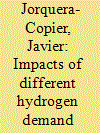

|
|
|
|
|
| Summary/Abstract |
As countries continue to update their climate ambitions, they are seeking cost-effective solutions for decarbonizing energy use. In this context, low-carbon hydrogen production and use presents relevant opportunities for emissions reductions and economic development, and recent studies show important potential benefits from integrating electricity and hydrogen networks. Based on a novel mathematical optimization model, we conduct a case study for Chile in 2020–2050 to assess the least-cost evolution of the integrated hydrogen–electricity system, testing different carbon prices, 100% renewable mandates, and incorporating domestic and international hydrogen demand. By optimizing over various scenarios, we find that, due to the country’s significant renewable potential and the flexibility that electrolyzers can provide, adding hydrogen exports to domestic hydrogen use may enhance renewable integration, while not necessarily increasing average wholesale electricity prices for typical end-users (relative to our baseline scenario), but also make battery deployment unattractive. Further, we conclude that climate policies such as a high carbon price or a 100% renewable mandate may be crucial to achieve a fully renewable system by 2050 and reduce cumulative emissions, resulting in 3%–14% higher net present system costs. Finally, we discuss that various concerns such as water and land use must be addressed by policymakers.
|
|
|
|
|
|
|
|
|
|
|
|
|
|
|
|
| 20 |
ID:
121302
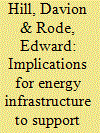

|
|
|
|
|
| Publication |
2013.
|
| Summary/Abstract |
With recent political, social, and environmental concerns regarding energy use and consumption, there is a need to address sustainable solution for the production of fuels and petrochemical intermediates. While there are many efforts in biological or biochemical fuels production, there are also ways to convert electrical energy to hydrocarbon and petrochemical intermediates that compliment an assortment of electrical energy storage and conversion pathways. An electrical replacement for hydrocarbons must have all of the desirable qualities of hydrocarbons without the environmental and energy security consequences. These qualities should include accessibility, low energy investment, reasonable energy density, portability, chemical versatility, and combustibility. To that end, a background on energy requirements for electrochemical pathways to petrochemical intermediates will be provided, followed by an analysis of the electrical infrastructure required to support large scale adoption.
|
|
|
|
|
|
|
|
|
|
|
|
|
|
|
|
|
|
|
|
|